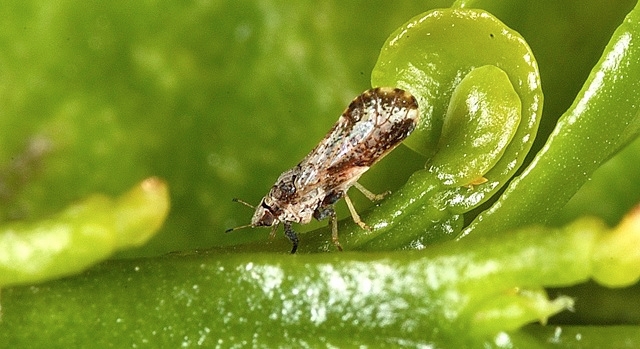VISALIA – Last week's California Citrus Conference marked a major milestone for growers, and it wasn't just the 50th anniversary of the Visalia-based Citrus Research Board (CRB). It was a resounding revelation that new research may cure the greatest threat to the citrus industry in the next few years.

Michelle Heck, a molecular biologist with the USDA Agricultural Research Service, discusses her research to breed a new citrus pest that does not transmit the fatal tree disease known as huanglongbing. Photo by Michael Alvarez.
Michelle Heck, PhD, told the crowd of citrus growers at the Wyndham Hotel on Oct. 10 that her team might only need that much time to inbreed a generation of Asian citrus psyllids that are incapable of transmitting the deadly tree disease known as huanglongbing (HLB). The disease has already destroyed China's citrus industry, decimated Florida and Texas growing regions and is currently killing the citrus industry in Brazil.
One grower commented, “China's been dealing with this for 100 years and Brazil for 14 years. We've had this for four to five years in California and we are already knocking on the door of nailing it. That's impressive!”
Heck, a molecular biologist with the USDA Agricultural Research Service, was the first to lead a team of scientists to study the proteins involved in the interaction of the pest, plant and pathogen. One of those proteins creates a blue color in the blood of some psyllids. Her research revealed that psyllids containing the blue protein are far less efficient at transmitting HLB to the plant than others. She then bred those psyllids and took their progency and raised them on orange jasmine hedges, better known as Murraya, a plant the psyllids are attracted but is HLB resistant. The combination of the pest and plant reduced transmission of HLB to healthy citrus leaves from 32% to 2.9%.
Heck said the next steps are to continue breeding the pests that are poor transmitters of the disease to create a line of psyllids that do not transmit HLB at all. She said it would take another two years to breed an “optimized line” of the psyllid but once that was complete, that line could begin mass breeding for release.
“By sheer numbers, we can tip the scales [in the fight against HLB],” she said, “but it's unknown if these lines will out compete other psyllids [in the field].”
One grower asked if the non-transmitting line of the pest would be considered a genetically modified organism, or GMO, a distinction that could hurt fruit grown in groves with the new pest. Heck said all of the psyllids would be bred natuarally, so there is no genetic alteration of the insect itself.
“This is something the anti-GMO groups should feel good about,” Heck said.
Best Case Scenario
Victoria Hornbaker, Statewide Citrus Program Manager for the California Department of Food and Agriculture (CDFA), called the current HLB situation in California a best case scenario. She said the Citrus Pest and Disease Prevention Program's (CPDPP) No. 1 priority is to quickly detect and remove diseased trees. Shortly after the discovery of the first HLB tree in 2012, California's myriad of citrus agencies worked together to quickly implement measures to control movement of fruit and nursery stock, monitor and suppress the ACP population, and begin working on ways to detect the disease and possibly cure it.
“Instead of all commercial groves being covered by a quarantine, we said we're going to quarantine the whole state,” Hornbaker said.
By limiting the movement of citrus in and out of different quarantine zones, there is less likelihood of transporting trees from an infected area to an uninfected area. If any infected trees are discovered, they are removed, destroyed and replaced with a healthy tree. There are many early detection techniques (EDTs) being studied throughout the country, including looking for patterns in leaves, chemicals produced by trees in response to HLB, and studying molecules of the bacteria causing the disease. A recent analysis of these EDTs showed that most are about 95% effective in identifying an infected tree, and that losing 5% of healthy trees is an acceptable loss compared to devastation caused by the disease spreading unchecked.
While early detection methods of ACP are still being perfected, the fight to control the spread of the psyllid is not. After research identified the microscopic parasitic wasp radiate terminaxia as the natural enemy of the psyllid, they began working to mass produce and release them. To date, more than 11 million wasps have bee released in citrus growing regions since 2013, the closest being in Kern County.
Reproduced from Sun Gazette:
http://www.thesungazette.com/article/news/2018/10/17/pests-that-spread-citrus-disease-are-key-to-cure/
Attached Images:
